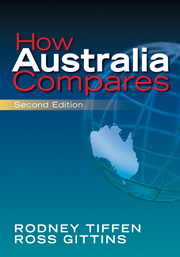Book contents
- Frontmatter
- Contents
- List of tables and figures
- Preface to the second edition
- Acknowledgements
- Reading the tables
- Abbreviations
- Introduction
- 1 People
- 2 Government and politics
- 3 Economics
- 4 Work and labour
- 5 Government taxes and spending
- 6 Health
- 7 Education
- 8 Inequality and social welfare
- 9 International relations
- 10 Environment
- 11 Science and technology
- 12 Telecommunications and computing
- 13 Media
- 14 Family
- 15 Lifestyles and consumption
- 16 Crime and social problems
- 17 The search for scoreboards
- 18 The Howard impact
- Sources and references
9 - International relations
Published online by Cambridge University Press: 05 June 2012
- Frontmatter
- Contents
- List of tables and figures
- Preface to the second edition
- Acknowledgements
- Reading the tables
- Abbreviations
- Introduction
- 1 People
- 2 Government and politics
- 3 Economics
- 4 Work and labour
- 5 Government taxes and spending
- 6 Health
- 7 Education
- 8 Inequality and social welfare
- 9 International relations
- 10 Environment
- 11 Science and technology
- 12 Telecommunications and computing
- 13 Media
- 14 Family
- 15 Lifestyles and consumption
- 16 Crime and social problems
- 17 The search for scoreboards
- 18 The Howard impact
- Sources and references
Summary
Military spending
Table 9.1 shows that on average among these established democracies the proportion of national income devoted to military spending has declined substantially over the last generation, and in 2006 was half what it was in 1970. Even in the last two decades of the Cold War, military spending did not keep pace with the growth in national incomes, but the end of the Cold War brought a substantial peace dividend.
In the decades leading up to 2000, military spending as a proportion of GDP fell in all the selected countries. In some countries, this meant an absolute decline in military spending. More commonly it meant that military spending grew less quickly than the economy. The decline has not been as even as the decade intervals in the table might suggest. The United States increased its military spending greatly during the Reagan era, peaking at 6.6% of GDP in 1986. Similarly, according to figures from the Stockholm Institute for Peace Research (SIPRI), one of the two major world centres for compiling military data, world military expenditures reduced from 1987 to 1998, but then began climbing again.
In terms of manpower, however, the decline was absolute, not just relative. The size of the armed forces in the selected countries in 2000 was less than half the 1970 totals (Table 9.2).
- Type
- Chapter
- Information
- How Australia Compares , pp. 148 - 151Publisher: Cambridge University PressPrint publication year: 2009



